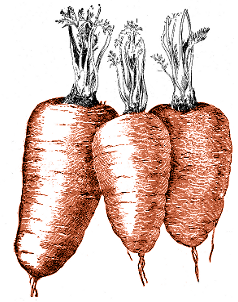Archive for September, 2011
Posted in Retrospective, The Old Garden In Bristol on Tuesday, September 27th 2011 (6.29 PM).
Before we start to plan what will be going where next year, I thought it would be worthwhile putting together a brief list of what we’ve done this year, and how well it worked. And, when it’s all written down on a page, it does look like we’ve managed an awful lot. In 2011, we have grown:
- First early potatoes
- Peas
- English marigolds
- French marigolds
- Sweet peas
- Beetroot
- Spring onions
- Carrots
- Swiss chard
- Japanese saltwort
- Radishes
- Pattypan squash
- Wild Rocket
- Violas
- Marjoram
- Mint
- Basil mint
- Basil
- Runner beans
- Green beans
- Nasturtiums
- Thyme
- Feverfew
- Camomile
- Sage
- Curled parsley
- Flat parsley
- Chives
- Dill
- Coriander
- Salad leaves
- Lavender
Yes. A long list. Some of it worked, some didn’t, and an awful lot can be filed under “sort of worked, but we could have done better”. All of these things were planted in various sizes of container around the garden, nothing in the back bed at all, because we are still digging it up in an attempt to root out all the broken glass and make it safe to dib holes in with our fingers. I will, in the next few posts, break down the unmanageable list above into successes, disasters, and the catch-all “somewhere in between”.
list, review
Posted in Planning, The Old Garden In Bristol on Sunday, September 25th 2011 (2.27 PM).
Before we start planning for next year, I thought I’d explain a little about the position of Symbolic Towers: the size of the garden, and the space we have to work with. So, I’ve drawn a little roughly-to-scale diagram. Stupidly, I forgot to put a north arrow on it: north is in the bottom-right corner.
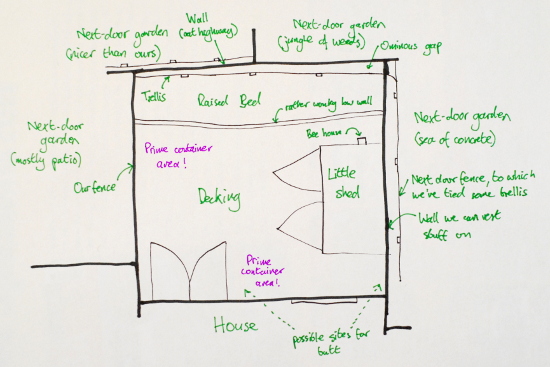
We are, according to aerial photos, roughly square, and facing south-west. Most of the garden is covered in decking; along the back, there is a raised bed formed by a wall, which is neither straight nor vertical. The bottom of the raised bed, incidentally, is largely sealed with cement, and the soil inside it is the usual urban garden mix of grit, broken crockery, broken glass, and lumps of coal.
Behind the raised bed is a wooden trellis, which starts off tight up to the back wall of the garden at one end, but is about 6 inches away from it at the other. This leaves an ominous gap which is largely used by invading cats. Our best plan for this gap is to fill it with rocks and logs, for the benefit of beetles and other wildlife. The back wall of the garden is fairly low, and is used by the said invading cats as an easy route through the neighbourhood.
The wall on the right-hand side of the garden – the north-west side, if you’re keeping track – is a similar height, about 4 feet, and is a good spot for pots and boxes where the shed isn’t in the way; although the shed itself, being a small one, is no higher than the wall. The neighbours on that side have put up a high wooden fence on concrete posts, a good few inches back from the line of the boundary; we’ve tied a willow lattice onto the back of their fenceposts, in the hope of improving the appearance a bit. On the opposite side, the fence is on our side of the boundary, and is a standard 6-foot wooden panel fence; we’ve stained it, and the shed, green.
What with the south-western aspect, and the high fences all around, there’s a variety of conditions. The wall of the house gets plenty of sun and heat; but the back left corner of the bed is almost always in shade, a thin skin of algae usually growing across the soil surface. The back right corner of the bed is brighter, but is always under threat from the overgrown mass that is the garden of the neighbours on that side: tendrils of bindweed and reaching branches of bramble always probing into our garden from that direction. Our prime growing sites are: the area on the left in front of the bed, which gets a lot more light than a couple of feet further back; and the area in front of the kitchen window, next to the back doors. We’re tempted to use up some of that space, though, for a water butt; most of the house’s water catchment drains into a downpipe by the kitchen door, and it would be criminal not to even try to consider saving some.
introduction, plan, sketch
Posted in Garden Diary, The Old Garden In Bristol on Sunday, September 18th 2011 (9.43 PM).
Since the last “week in the garden” post, we have:
- Done nothing, because we went away on another holiday.
And, the garden hasn’t enjoyed it at all, although I have no idea what the weather was doing. Some of the beans are healthy, but some are rather withered and shrivelled. The spring onions, lovely and healthy a couple of weeks ago, are now looking fairly unrecoverable. The bolt-free coriander seeds we carefully sourced have come into flower, which makes me think it was probably too hot and dry to leave a container garden to its own devices for a week. On the bright side, the Swiss chard is happily sprouting up again with some vigour, when we thought we had harvested all we could get from it.
Still, we always said: after the September holiday we would start planning next year’s garden; start getting ready for the winter and working out our planting. Next weekend we start hacking back the perennials and working out how long it is worth keeping the beans and so on in their planters for; and after that we sit down with pen, paper, charts and calendars, working out what to plant when. So, coming up soon: some posts on how our garden is arranged, situated, and what we think we can do with the space.
autumn, coriander, diary, disaster, green bean, holiday, runner bean, scallion, spring onion, swiss chard
Posted in Experimentation, Garden Diary, Photobloggery, The Old Garden In Bristol on Wednesday, September 7th 2011 (10.14 PM).
Since the last “week in the garden” post, we have:
- Harvested the first green beans.
And, because we went away for a long weekend, that was about it. The garden didn’t take too kindly to us going away, either. Or, rather, it didn’t take too kindly to the weather: the combination of dry, hot days without us there for watering, followed by heavy rain, has not had good results. The spring onions have suffered in particular, and the runner beans have also had problems.
Back in the mists of time – well, August – before this blog had properly started, we sowed a few boxes of quick-growing things to give us some more produce into the autumn. As I mentioned then, I tried an experiment. All of the seeds were sowed into previously-used compost; and for each seed, I sowed one box into compost that had been used to grow peas, and one box into compost that hadn’t. It’s three-and-a-half weeks later now, and the results are pretty clear, at least for the radishes.
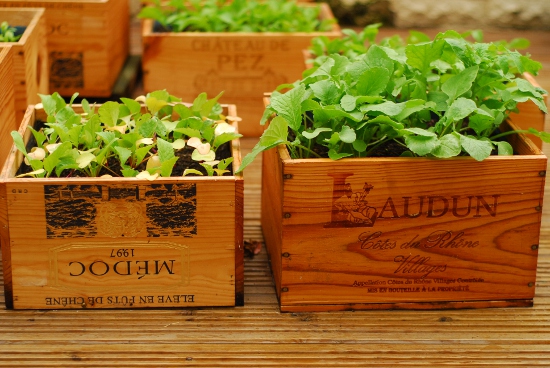
The pea compost is, I’m fairly sure, the one on the right. Science!
bean, compost, diary, experiment, french bean, green bean, nitrogen, pea, radish, scallion, science, spring onion, weather
Posted in Inspiration, Photobloggery on Saturday, September 3rd 2011 (11.38 AM).
As I’ve said already, despite the title, our garden isn’t a forest garden. It’s too small, for one thing. As you can see, it is a little patch which is ideally suited to being a container garden, but completely unsuited to becoming a lush, verdant, dappled-sunlit forest.
That doesn’t mean forest gardens aren’t inspirational, though. Or any garden which is mature enough to have a depth and richness to it, so long as its gardeners allow it to stretch itself and develop.
My first “inspiration” post, then, is a large, rambling National Trust garden one can easily get lost in: Kingston Lacy, Dorset. I’ve seen mixed reviews of it online; but the poor reviews didn’t really explain just what they didn’t like about it. Its formal gardens aren’t that special gardenwise, but they do have an unusually large amount, for Dorset, of Egyptian archaeology scattered through them. Further away from the house, though, the themed gardens are much more natural-feeling; whereas the formal garden could have been shipped in yesterday, the other gardens definitely feel grown-in, even though they have been largely restored in the past 30 years.
First, the walled Fern Garden, including a field mouse I managed to capture a quick snap of before it saw us and fled.
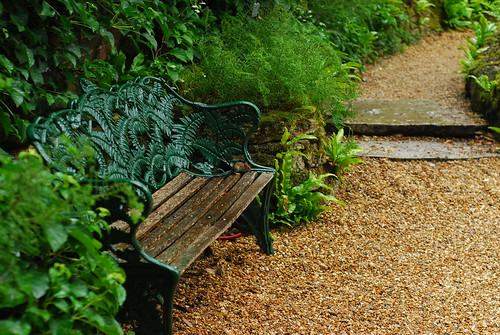
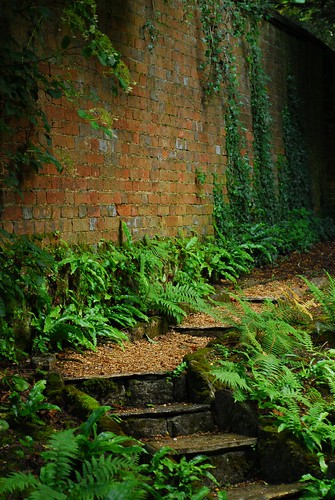
One of the largest parts of the gardens at Kingston Lacy is the Japanese garden, originally Edwardian, rebuilt in the early 90s. It includes several parts: a formal tea garden, a daisy maze overlooked by a bamboo shelter, and a more wooded area, blending in with the older trees fringing it. When we were visited, we were caught in a sudden summer downpour, so sheltered with our umbrellas, trying to take photos of the raindrops.
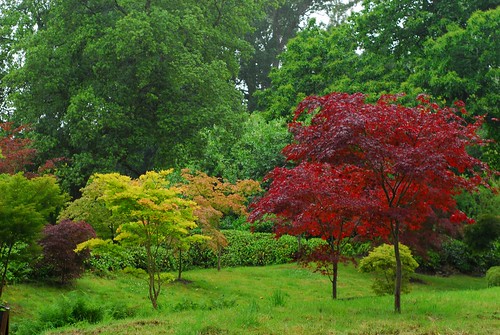
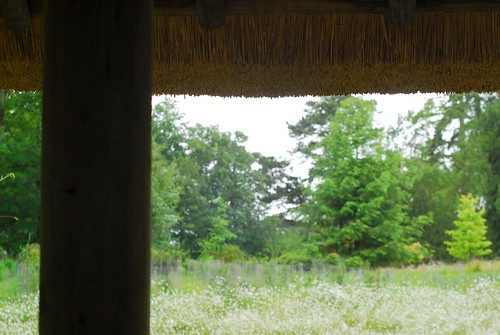
dorset, fern, fern garden, japan, japanese, japanese garden, kingston lacy, national trust, public garden, themed garden

